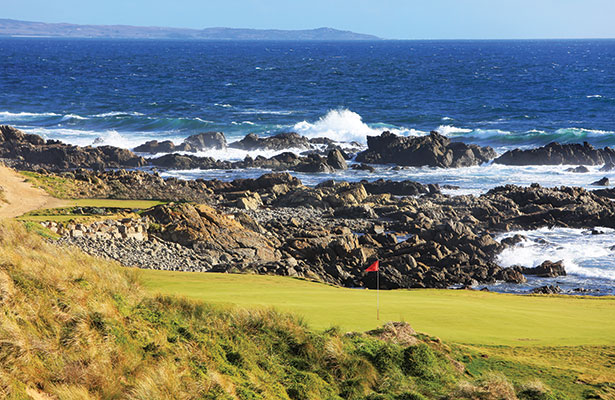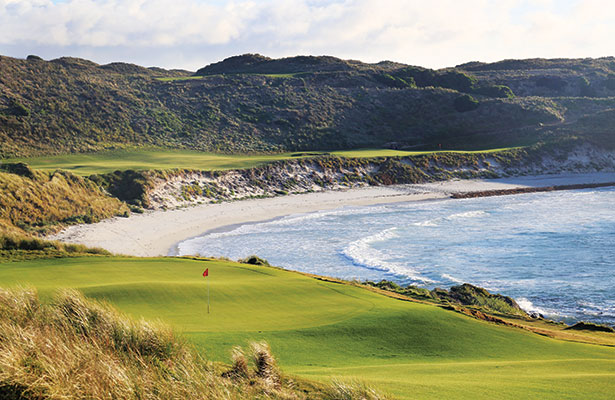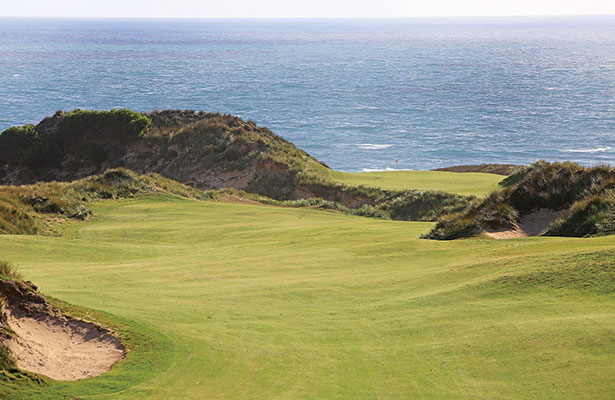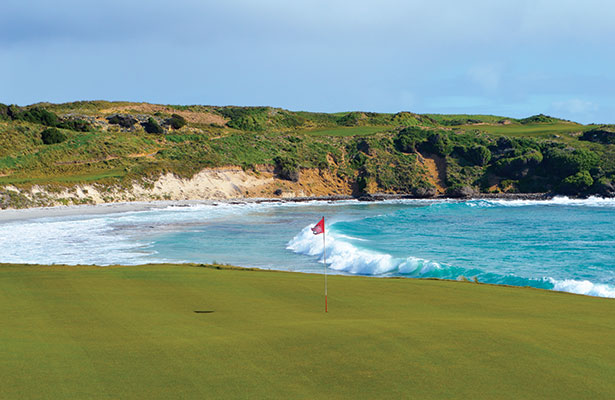Brace yourselves. The world’s most highly anticipated new golf course opens its gates later this month. We thought we’d get in early and play Cape Wickham on Tasmania’s King Island following a wave of international fanfare. Our verdict? Believe the hype.
YOU’RE building a golf course where?
It was a common question asked of those involved in the development of the highly anticipated Cape Wickham golf course on King Island. Isolated and seemingly inaccessible in the middle of Bass Strait, King Island is known on the mainland for its cheese, beef, seafood and, perhaps if a really eager historian, its maritime narrative.
The western coastline here was once regarded as one of the most dangerous in the world. In the 1860s, after several deadly shipwrecks, action was taken with the construction of the Cape Wickham lighthouse near the island’s northwestern tip. Measuring close to 50 metres, it remains Australia’s tallest.
In the shadows of this epic structure is an irregularly shaped shoreline and sand dune terrain that Mother Nature seemingly left on earth for the purpose of great golf. This really is the ‘kitchen sink’ of links golf sites, with everything from a dramatic rocky headland, sandy white beach and cove, enormous dune corridors and holes set right down on the rocky shoreline thrown into the mix. Plus, you have the highest lighthouse on any golf course in the world. From all angles the Cape Wickham development looks a knockout, with the course likely to debut highly in Australian Golf Digest’s Top 100 Courses ranking in March. Despite its many accolades already, this was far from a sure thing and an almighty risk for developer Duncan Andrews to take.

Did you know? Access onto King island is by plane only, from Victoria’s Moorabbin and Tullamarine and from Launceston via Burnie on the Tasmanian mainland. Beyond schedule services offered by REX, Sharp Airlines and King Island Airlines are chartered services from companies like Vortex, Kirkhope, Air Adventure and Flight Group. Flight time from Tullamarine is under 45 minutes. Australian Air Holidays also offer packaged tours to King Island. Check them out at australianairholidays.com
Overcoming Obstacles
THE Cape Wickham site was actually discovered by Andrew Purchase, former boss of golf course construction company Turnpoint. Purchase first ventured onto the island in 2011, falling in love with the site and buying a large chunk of freehold land immediately south of the lighthouse.
The land was dramatic but steep, and overlooked some of the most spectacular coastal frontage anywhere in golf. After enlisting the help of Australian Golf Digest’s own Darius Oliver to study the land and explore the possibilities, it became clear they would need to access crown land along the ocean as well as some additional dunes further to the south.
It was around this time that Oliver introduced little known American golf course designer Mike DeVries and successful golf entrepreneur Duncan Andrews to the property. Andrews, the owner and developer of O over in Victoria, was immediately smitten and agreed to finance the project subject to a long-term lease being issued by the Tasmanian authorities to use the coastal crown reserve. This land was essential to the routing of the golf course, with parts of the first three, final four and 10th through 12th holes touching this government land.
While the virtues of a golf course on some marginal dune land on a remote island might have seemed an easy argument to mount, in the case of Cape Wickham it was anything but simple. Building the golf course would mean destroying several thousand Short-tailed Shearwater burrows on the site, some of which were on the crown land. Shearwaters, or mutton-birds as they are more commonly known, are the most abundant seabird in Australia and breed in colonies across mainland Tasmania and its islands. Cape Wickham is home to as many as 40,000 burrows, and permission to build the golf course relied on the development team convincing the authorities, as well as the environmental lobby, of the project’s social and environmental upside. These upsides included obvious benefits like jobs and tourism onto the island, but equally the protection of the mutton-bird colony.
Each of the birds displaced by golf course construction at Cape Wickham would have ample room to relocate, and protection into the future through the closing of the rookery for local recreational harvesting and the removal of invasive weed species and threats such as cattle and feral cats. Although there are some areas where the birds appear to have tried digging into the fescue playing surfaces, generally the relocation looks to have been a big success with the birds and the golf holes surviving and thriving harmoniously.
Golf often gets a bad environmental rap, but King Island is an example of sensible planning and thoughtful development working together to produce favourable results for the island. There are certainly lessons here for future developers to follow.

Did you know? King Island attracts less than 8,000 tourists per year. Cape Wickham is hoping to bring at least that many for golf alone.
Building World-Class Holes
BEYOND the success of the planning process, the chief lesson to take from Cape Wickham is not to compromise on the golf. As Andrews and Oliver both pointed out, the only way for them to combat the remoteness of King Island was for the golf course to be singularly outstanding.
“It would be hard to see this thing making any financial sense at all unless you were able to build something truly world-class,” Oliver says. “We knew from day one that the site was good enough, and after considering hundreds of different options, that the routing was as well. It was then just a matter of building great holes.”
Australian Golf Digest played the course in August and the greatness of some of those holes was apparent at first glance to the editors. The opening stretch is incredible, and played atop a rocky peninsula the locals call Cape Farewell. It seems an appropriate name for the journey golfers embark upon. The very first hole features about as exhilarating a tee shot as you’ll find anywhere in the world, with big Bass Strait views and water lurking down the right. Although the fairway is quite wide, the landing area seems to shrink when the crosswinds pick up. The second fairway is even wider and almost impossible to miss unless aggressively trying to drive up the narrow side. Its green rests spectacularly at the western tip of the Cape, near a collection of rocks often populated by visiting fur seals. The third is a longish par 3 played towards a pair of offshore islands, and with disaster waiting for those missing right. Fortunately there is a huge bailout area to the left and a green of 1,000 square metres to hit.
The most incredible part of the opening sequence is not how good the holes are, but how quickly they appear overwhelmed by the rest of the golf. The finishing run is ridiculously scenic. In between are some glorious inland holes and a four-hole stretch (9-12) around the turn that might trump anything we have in Australia – a part of the course Andrews aptly titles “OMG Corner”.
Pleasingly, the course that DeVries and Oliver designed is extremely wide and forgiving for the average golfer and bunkered sparingly around the greens to allow all sorts of creative approach and recovery shot options. The coastal scenery is ever-present but varied, and the lighthouse stands like a beacon on a number of holes, most notably the fourth where the golfer first turns inland and hits straight towards the giant target.
The vegetation is another beautiful feature of Cape Wickham, and wonderfully diverse with a mix of native grasses like marram and dune tussocks, to an array of low-growing succulents and bushes along the shoreline.
The risk of sensory overload at Cape Wickham is very real and at times unexpected. Of the inland holes are a couple of genuine showstoppers, each with design features or settings not seen in this country before. The tiny par-3 seventh is angled like the 12th at Augusta but played across a pronounced chipping valley rather than a creek, and with the back of its shallow green set at the base of a rock escarpment rather than a flower bed. Again the lighthouse stares you down as you hit the tee shot. The next is an intimidating par 4 with a partly blind tee shot played across a natural sandy waste, to a fairway that is enormously undulating and far more forgiving than it appears from the tee. Just as the rocky bank on 7 was unexpected, so too is the dizzying valley fairway that most closely resembles what you find somewhere like Barnbougle Dunes. The final inland hole is another beauty. Played downhill and with the prevailing wind, the long par-4 14th bends around a string of bunkers and heads towards a charming natural punchbowl green set at the base of an enormous 80-foot sand dune known to the design team as ‘The Beast’. The next is a par 5 that gets closest to the lighthouse, and a green pushed against the water looking out towards Victoria.

Did you know? There will be 20 twin/double rooms available on site at Cape Wickham by the end of the year. Each has breathtaking views north across Victoria Cove and straight towards the lighthouse.
A Finish To Remember
THE final three holes at Cape Wickham are set along the ocean and are, quite simply, unforgettable. The views from the 16th fairway and 17th tee across Bass Strait and towards the Cape Farewell holes are sublime, while the 18th will make strong claims for the best finishing hole in the country – its fairway bending directly above the Victoria Cove beach, which is in play from the tee and also on the approach. The design here couldn’t match the setting any better, just one solitary bunker front left of the green to complicate play for those who drive too safely away from the water.
All told, there are eight holes at Cape Wickham that run along the coast and another couple with greens that appear directly on the water. Every hole has an ocean view, and it’s hard to imagine any course anywhere on earth with quite as many thrills. Pebble Beach is the most obvious comparison because of its irregular coastline, but Wickham’s inland holes have far more drama and interest than Pebble’s and the site itself is much more rugged.
Ultimately, Cape Wickham is a one-off and hard to compare to anything else. It’s a credit to Andrews, DeVries, Oliver, Purchase and all those involved in its creation for having the patience and resolve to see the project through and pull this off. Whether golfers visit King Island in sustainable numbers to play the course remains to be seen, but what is clear is this – those who do visit will get to experience one of the world’s best new golf courses.
Sharp Airlines is the premium provider of air services with daily flights servicing Victoria, Tasmania and South Australia. Fly to the emerging golf mecca that is King Island from Launceston (45 minutes). A new Hobart to Burnie/King Island service will also commence in September. Sharp Airlines also offers holiday packages for individuals, couples, families, golfing enthusiasts and adventurers. Packages offer combinations including airfares, accommodation and car hire to suit a variety of budgets. Contact the reservations team on 1300 55 66 94.

What tourists are saying about Cape Wickham…
“Cape Wickham is easily the most picturesque course I’ve ever played and probably the most fun. I think it took me 4 hours to play because I took so many pictures.” Jeff Bertch, New York, USA
“My husband and I have played golf courses that are rated in the top 10 in the world. Cape Wickham truly is the most beautiful course we have ever seen. It is a masterpiece.”Sheela Bertoldi, River Landing Golf Club, USA
“Golfers tend to want to compare courses they have played, some all over the world. There is nothing to compare Cape Wickham to – anywhere. An awesome golf experience.” Sue Hennessy, USA
HOW TO PLAY CAPE WICKHAM
Now open for bookings (play from October 30, 2015)
18 Hole Rate – $150; All Day Rate – $195
Carts – $45; Hire Clubs – $50; Pull Buggies – No charge
Contact [email protected] to book a round
Golf packages are available through golftourismaustralia.com, vortexair.com.au and airadventure.com.au




